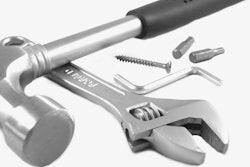
Selling is an integral part of your feed and grain business every day, and we are sure that you have extensive experience with selling. However, when was the last time you thought about your selling approach and identified factors that could improve your sales effectiveness?
In this column we use the four steps of the selling process to help you think about your customers and how to create a more effective relationship — making them more successful and you more profitable.
In the feed and grain business you often sell to two different groups of customers. First, you must sell your services to farmers who shop for where they sell their grain and purchase their inputs, and then you must sell to those who purchase grain from you. The same key parts of the selling process hold for both groups. In this article we not only review the main components of the selling process, but we invite you to take out a pen and pad of paper and actively engage in the exercises throughout the column. By the end of the article you will have a great set of ideas to put into action.
We would like to attribute many of the concepts in this column to “Mr. Sales,” Dr. David Downey, professor emeritus of agricultural sales and marketing and executive director of the Center for Agricultural Business at Purdue University.
What is sales and marketing?
To ensure that we are all on “same page,” we begin by discussing what we mean by sales and marketing. While sales and marketing are integrally related — there are important differences. Sales are short term while typically the focus with marketing is longer term.
Generally, in sales we consider one customer at a time while in marketing we look at customers as a group. Selling is sometimes referred to as the “last three feet” of the marketing process or where the “rubber meets the road.” You are actively involved in sales when you are working with a farmer on a package deal to buy their corn and provide drying services. Effective selling is part of a good marketing plan, which involves how you position your mix of products and services, your pricing, your hours of operation and locations, and your promotions.
Many people immediately think of the pushy salesperson when they think about sales and selling. This stereotypical salesperson is focused on closing the sale as quickly as possible, is not interested in paying any attention to the customer’s needs, and may even be manipulative. This is an unfortunate image because good selling is not “pushy” or manipulative. We outline the important characteristics and the mutual benefits that good selling practices deliver to you and your customers.
Good selling is about learning your customers’ needs and helping them understand how you can provide value for them. Selling is effectively and logically communicating the value proposition of your product and/or service. There are four parts to an effective selling process: probing, communicating features and benefits, handling objections and closing.
Probing
Probing is the vital first step in the selling process as it is the process of finding out what your customer needs. Through probing, you demonstrate to your customers that you want to help them, that you are knowledgeable and have valuable information for them and that you care about them. Since you want to learn about your customer and their needs, you will be asking the questions. As your customer responds to your questions, he/she will understand more about what their needs are and what problems they want to solve. During the probing process you, as the salesperson, are not the only one who learns more about the customer needs, but just by talking it out, your customer better understands their needs as well.
Effective probing involves asking questions, listening and observing. A common mistake that salespeople make is that they talk too much during the probing process. During this stage the focus should be on the customer. As the salesperson, have the discipline to listen to their needs and how you can help solve their problems. During this stage you want your customer to talk, but not about just anything, so keep the discussion focused by asking the appropriate questions.
Pen and paper exercise:
List three questions that you believe would be applicable to your target customers to help you (a) get the conversation started, and (b) uncover important information about your customer’s needs, problems and values. Examples in the grain business might be: “What services does your grain company provide for you? Are there things you wish they did better? Are there beneficial grain handling or merchandising services that you should consider offering?”
Now that you have generated three questions, go back and take a look at them. Are these questions open-ended or closed questions? Closed questions suggest a specific response (often a response of just a few words or a short phrase with specific data). Open-ended questions allow your customer to talk. During the probing process, it is more effective if you focus on open-ended questions or questions that you customer will not be able to answer with a simple “yes” or “no” or a quick one-or-two-word response.
Remember that during the probing stage you are learning about your customers’ needs. Good open-ended questions often start with “What,” “Why,” or “How.” Don’t worry if there are specifics you are not learning about right now. You can use a closed question later in the selling process to learn the specific details you need to know (e.g. number of loads or timing of delivery).
There are a couple of common mistakes salespeople make at this step. One mistake is the salesperson talks too much or interrupts the customer. When the customer talks, you almost always learn something that could be useful down the road when creating a value bundle for the customer. Two other common problems are asking the wrong questions and assuming you know what the customer needs.
You are almost ready to move to the communicating features and benefits stage, but, first you need to build the bridge for the transition. Only after you have a good understanding of your customer’s needs, can you summarize what you have heard and suggest a recommendation. Now is the ideal time to ask for additional information to find any missing pieces. Be careful to stay focused during this transition. Only talk about the parts of your product and/or service that are relevant and beneficial to your customer.
Communication of features and benefits
Features and benefits are distinct and important aspects of your sales story. You need them both but be careful not, confuse them. Features are the facts about your product, service or company and can be seen, touched, smelled, measured, demonstrated or proven. Customers may be interested in features as a basis of comparison. However, for most customers you will need to move beyond features in order to secure the sale because customers ultimately purchase benefits rather than features.
Benefits are the end result of features and allow the customer to solve a problem. As the salesperson, your goal is to explain how your product or service solves a customer’s problem. An effective way of doing this is to translate features into benefits for your customers using the features, advantages, benefits (FAB) approach.
For example you might use the following statement when you are selling grain to a processor: “Because we have a state-of-the-art grain drying system, the corn that we deliver to you will be free of stress cracks and allow your production process to be more efficient.”
Pen and paper exercise:
List three features (facts) about your product/service your customers have identified as important. Next, beside each feature list an important benefit of that feature for your customer. Then go back and check that you can complete the following phrase: “Because our product/ service ________ (highlight feature) you will be able to________ (highlight benefit). An example in the feed business might be: “With our Heavy Hog Finisher ration, your market hogs will have better average daily gain, which means they eat less feed and can be moved to market more quickly — which allows you to both save money and put more hogs through your facility each year.”
Handling objections
Objections are a normal and regular part of the selling process and need not be feared. We know that many salespeople worry about objections — but objections can be anticipated, planned for and don’t need to be a problem. There are three common causes of objections: (1) misunderstanding, (2) lack of information, and (3) legitimate reasons or concerns not to accept the product/service.
Customer objections can come in a variety of forms. Sometimes it seems a customer is delineating an objection when they are really just asking a question for more information. If this is the case, be patient and answer honestly. Often with more information and clarification the customer will be “on board.”
It is important here to check for understanding after you answer the customer’s question. Sometimes the objections that customers raise are, in fact, false objections or “smoke screens.” The customer may point out things that are beyond your control. It can be difficult to determine the difference between a real objection and a smoke screen, and you need to be cautious. For smoke screens the best approach is to help the customer work through all of the other questions they have so they have complete information.
A key point to remember is that customer objections are in no way a sign of failure. In fact, the opposite is true. When a customer raises an objection, it is a clear sign they are paying attention to the points you are making and seriously thinking about your product or service. By carefully listening to your customers’ objections, you can learn what specific information your customers need before they do business with you. Many salespeople say “the only bad objection is the one that you don’t hear.”
You can, and should, prepare for objections that will come your way during the selling process. Most experienced salespeople indicate that 80% of the objections they encounter are ones they can predict, because they hear them from various customers. Being aware of this and taking appropriate action allows you to prepare an appropriate response for possible objections.
Pen and paper exercise:
List three objections (concerns that are a barrier to the purchase decision) that you anticipate hearing from your customers in a selling situation. Then beside each objection write down at least one idea for overcoming that objection.
There are a few tips will help you as you are handling objections. First, the words you use send a subtle and important message. Did you ever notice how the word “but” is harsh and can quickly turn the other person off? For example, “I understand that you have another supplier that you are very happy with, but we can provide faster service for you.”
The introduction of the word “but” in that sentence sends an implicit message to the customer you don’t care about the first part of the sentence. Try substituting the word “however” when you would have previously used “but.”
Second, avoid getting into arguments with your customers. You could end up winning the argument but losing the sale and who really wins in that situation (Hint – it’s not you?)
Third, help your customer save face. You can do this by accepting the blame for misunderstandings, letting them know that other customers think as they do or simply blaming the situation rather than anybody specific. A useful tool is the “feel, felt, found” phrase. For example you might say, “I understand how you feel about the price; other customers have also felt that the price is high and when they had a chance to use the product they found that the value was worth it.”
In handling objections be careful to listen to your customers, restate any objections to make sure that both you and your customer are talking about the same thing, ask for more information when you need it, and then handle the objection. In some cases your product/service will not be a good fit for the customer so know when to quit. It is better to quit and not burn bridges for future sales.
Closing
The final step, the “close,” is the culmination of the selling process. It entails asking the prospect for a firm commitment to purchasing your products or services. The objective of the close is to motivate the prospect to make a mutually beneficial decision. A successful close will accomplish your sales call objective and result in receiving an order — hitting pay dirt!
Many salespeople consider the closing to be the most daunting part of the selling process. After all, asking for the order is the “moment of truth,” and many salespeople have difficulty closing because they are afraid of rejection. While no one likes to be turned down, it is important to remember that the customer agreed to spend time with you, agreed to work with you to find a solution, and expects you to ask for their business. The best mind-set is to be confident and have a positive attitude.
Determining when the prospect is ready to buy (your opportunity to close) is an important part of the selling process, and comes by way of both verbal and nonverbal signals. By carefully tuning in to the customer, the salesperson can identify when it is time to close. Detecting verbal buying signals is one of the easiest ways to gauge the customer’s readiness for the close. For example, after the customer agrees on a key benefit, after you handle an important objection well, or when the customer asks about the warranty, you know it’s time to begin your closing. When the prospect has sufficient information to make an informed decision, CLOSE!
Nonverbal buying signals also provide insight into understanding where the customer stands in the buying process. Behaviors such as frequent eye contact, smiling, sitting up and leaning forward, an enthusiastic tone of voice, and making calculations or notes all help indicate the customer’s level of interest. When the customer is demonstrating interest and an eagerness to see the product at work in their business, CLOSE!
A focus on sales and selling can pay off
The four steps that have been discussed lead your prospect logically through the selling process. Probing is the salesperson’s opportunity to shine the spotlight on the customer in order to determine their wants and needs. Communicating features, advantages and benefits is your opportunity to match your product or service to the customer’s needs. Objections reveal specifics about what you must overcome to complete the sale, and anticipating the most common objections allows you to handle them skillfully. Closing means asking for commitment from the prospect to purchase your product/service.
A thorough understanding and incorporation of these steps into your sales calls will enable you to improve your sales effectiveness with your current customers as well as to attract new customers into your business. A key thing to remember is one of Dr. David Downey’s favorite quotes: “Nothing happens until someone sells something!”


















